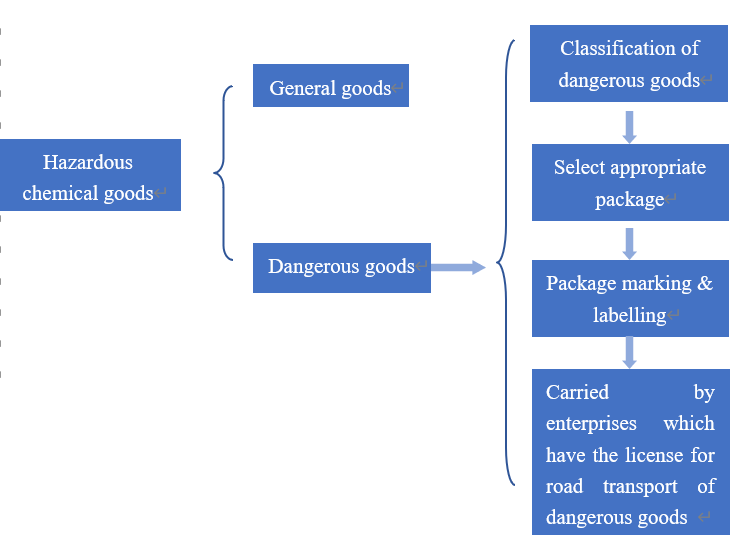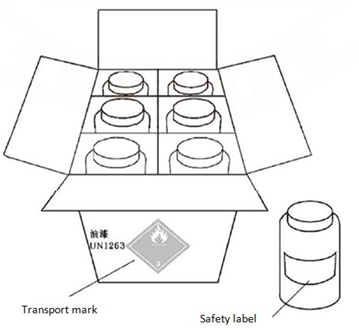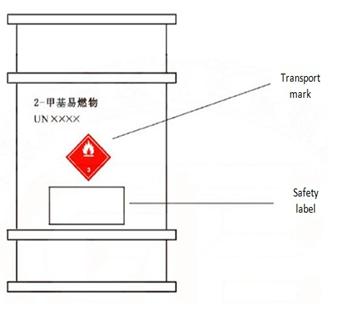Transportation of dangerous goods in China
Legal basis
"Regulation of the People's Republic of China on Road Transport" | |
"Regulation on the Safety Management of Hazardous Chemicals" | Order No.591 of the State Council |
"Regulation concerning road transportation of dangerous goods" | JT/T 617-2018 |
"General Specifications for Transport Packages of Dangerous Goods" | GB12463-2009 |
"Vehicle Mark for Road Transport of Dangerous Goods" | GB13392-2005 |
"Provisions on the Administration of Road Transport of Dangerous goods" | Order No.2[2013] of the Ministry of Transport |
"List of Dangerous Goods" | GB12268 |
"Classification and Code of Dangerous Goods" | GB6944 |
“Provisions on the Administration of Road Transportation Safety of Dangerous Goods” | Officially implemented from 1 Jan. 2020 |
Road transport process
According to "Provisions on the Administration of Road Transport of Dangerous goods", it is applicable to hazardous chemicals which belong to dangerous goods.

During transportation, the package of dangerous goods should be affixed with transport label. But in the actual transportation, in addition to the transport label, sometimes the package of dangerous goods should also be affixed with safety label, which depends on the packaging type.
Combination Packaging
For combination packaging: the inner package should be affixed with safety label and the outer package should be affixed with transport label.

Single packaging
For single packaging, both safety label and transport label should be affixed on the package. The two labels can be affixed on the same side or different sides.

Limited quantities (LQ) or Excepted quantities(EQ)
For transportation of dangerous goods in limited quantities or excepted quantities mode, the new “Regulation concerning road transportation of dangerous goods” (JT/T 617-2018) came into force on December 1, 2018 and the general rules have included exceptions and limited quantities of transportation. “Provisions on the Administration of Road Transport of Dangerous Goods” has been implemented from 1 Jan. 2020 and it specifies the adoption of limited quantities or excepted quantities mode during road transportation as a legal basis.
Storage for hazardous chemicals in China
"Regulation on the Safety Management of Hazardous Chemicals" | GB15603-1995 "Rule for Storage of Chemical Dangers" |
GB18265-2000 "Operation Conditions and Technical Requirements for Enterprises Handling Hazardous Chemicals Business" | "Catalogue of Hazardous Chemicals" (2015) |
GB13690-2009 "General Rule for Classification and Hazard Communication of Chemicals" | GB50016-2014 "Code for Fire Protection Design of Buildings" |
GB17914-2013 "Specifications for Storage and Preservation of Combustible and Explosive Goods" | GB17915-2013 "Specifications for Storage and Preservation of Corrosive Goods" |
GB17916 -2013 "Specifications for Storage and Preservation of Toxic Goods" |
According to Article 24 of "Regulation on the Safety Management of Hazardous Chemicals", hazardous chemicals shall be stored at designated warehouses, sites or store rooms (hereinafter referred to as “designated warehouses”) and managed by designated persons. Highly toxic chemicals and other hazardous chemicals stored in large quantities which constitute a major source of danger shall be stored in designated warehouses separately, the acceptance, distribution and safekeeping of which shall be under the charge of two persons. The way the hazardous chemicals are stored and the quantity thereof shall conform to relevant national standards or provisions.
The application scope of hazardous chemicals here hasn't been defined by the administrative authority. In order to reduce risks, it is advised that hazardous chemicals listed in class 1-8 or the "Catalogue of Hazardous Chemicals" be stored at hazardous chemical warehouses. And the warehouse class should be selected according to the fire hazard class of the storage items (shown as below).
Fire Hazard Classification for Storage Items | |
|---|---|
Fire Hazard Classification for Storage Items | Fire Hazard Characteristics for Storage Items |
A | 1. Liquid with a flash point of less than 28℃ 2. Gas with a lower explosive limit of less than 10%, solid substance that has a lower explosive limit of less than 10% under the influence of water or water vapor in the air 3. Substance that can decompose automatically at room temperature or can self-ignite or explode led by oxidation 4. Substance that can produce flammable gas and cause burning or explosion affected by water or water vapor in the air 5. Strong oxidant that easily cause burning or explosion when heated, hit, rubbed or treated with acid, organics, or flammable inorganic substances like sulfur 6. Substance that can burn or explode when hit, rubbed or exposed to oxidant or organics |
B | 1. Liquid with a flash point of not less than 28℃, but less than 60℃ 2. Gas with a lower explosive limit of not less than 10% 3. Oxidant that doesn’t belong to Class A 4. Flammable solid that doesn’t belong to Class A 5. Combustion-supporting gas 6. Item that can self-ignite caused by heat-accumulation and slow oxidation after exposed to the air at room temperature |
C | 1. Liquid with a flash point of not less than 60℃ 2. Combustible solid |
D | Hard-to-burn article |
E | Noncombustible article |

